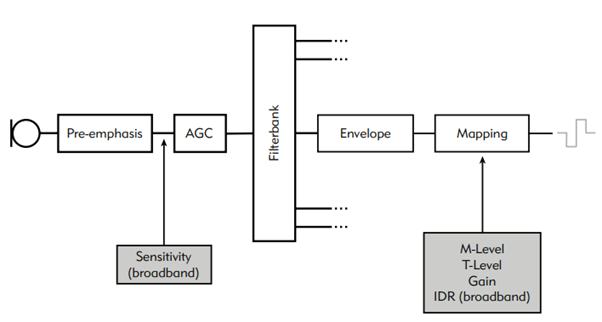Cochlear Implants: Difference between revisions
| Line 9: | Line 9: | ||
*Hilbert Envelopes (amplitudes) are calculated per band | *Hilbert Envelopes (amplitudes) are calculated per band | ||
*Signal amplitudes per band are mapped to current amplitudes | *Signal amplitudes per band are mapped to current amplitudes | ||
*Current amplitudes per band are convoluted with spiking patterns | *Current amplitudes per band are convoluted with spiking patterns and sent to the electrodes | ||
[[File:CI_signal_processing_scheme.png|CI signal processing scheme]] | [[File:CI_signal_processing_scheme.png|CI signal processing scheme]] | ||
Revision as of 10:06, 15 August 2024
Introduction
A hearing aid with or without a cochlear implants translates incoming sound into electrical signals that are directly stimulating the nerves in the cochlea. The process of converting the sound waves into electrical current is done by a sound processor outside of the ear. The steps are the following:
- Microphone picks up sound
- ADC converts analog signal to digital signal
- Pre-filtering is applied for speech emphasis
- Automatic Gain Control (AGC) is applied
- Signal is split into frequency bands by a filter bank
- Hilbert Envelopes (amplitudes) are calculated per band
- Signal amplitudes per band are mapped to current amplitudes
- Current amplitudes per band are convoluted with spiking patterns and sent to the electrodes
Pre-emphasis filter
Automatic Gain Control
Fast and Slow averagers
Compression
See Dynamic_range_compression on wikipedia for more background info.
Band filtering
Hilbert Envelopes
Spike patterns
The mapping function
Terminology of Critical Points in the Mapping Function
In scientific literature, three key levels are recognized: 1. hearing threshold, 2. comfortable level, and 3. pain threshold, each denoted in various ways.
The following abbreviations are commonly used to describe specific levels of electrical stimulation:
- T, THR, or THL: These stand for Threshold Level, or Threshold Hearing Level. This is the lowest level of electrical stimulation that the user can perceive.
- M, MCL, or C: These abbreviations stand for Most Comfortable Level, Maximum Comfortable Level, or Comfortable Level. This level refers to the point at which sounds are comfortably perceived—neither too loud nor too soft.
- USL, MSL, UCL, or LDL: These stand for Upper Stimulus Level, Maximum Stimulation Level, Uncomfortable Loudness Level, or Loudness Discomfort Level. This level indicates the point at which sound becomes painful or uncomfortable for the user.
The terminology can vary depending on the manufacturer. For example, for the comfort level in clinical software:
- Advanced Bionics uses 'M-level',
- Cochlear uses 'C-level',
- Med-El uses 'MCL'.
There can also be some variation in the precise definitions of these terms.
The term "Maximum Comfortable Level" is less commonly used and can sometimes refer to the highest level that is still comfortable, just below the pain threshold. This usage can be confusing and should be avoided where possible.
